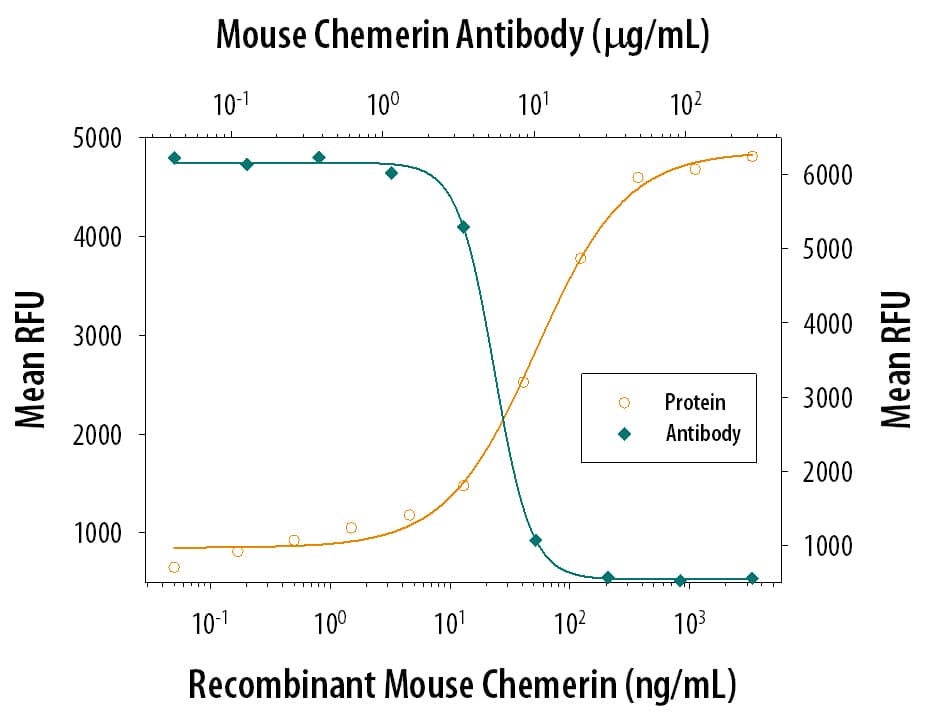Mouse Chemerin Antibody
R&D Systems, part of Bio-Techne | Catalog # AF2325


Key Product Details
Species Reactivity
Validated:
Cited:
Applications
Validated:
Cited:
Label
Antibody Source
Product Specifications
Immunogen
Thr17-Ser156
Accession # Q9DD06
Specificity
Clonality
Host
Isotype
Endotoxin Level
Scientific Data Images for Mouse Chemerin Antibody
Chemotaxis Induced by Chemerin and Neutralization by Mouse Chemerin Antibody.
Recombinant Mouse Chemerin (2325-CM) chemo-attracts the BaF3 mouse pro-B cell line transfected with human Chem R23 in a dose-dependent manner (orange line). The amount of cells that migrated through to the lower chemotaxis chamber was measured by Resazurin (AR002). Chemotaxis elicited by Recombinant Mouse Chemerin (100 ng/mL) is neutralized (green line) by increasing concentrations of Goat Anti-Mouse Chemerin Antigen Affinity-purified Polyclonal Antibody (Catalog # AF2325). The ND50 is typically 3-9 µg/mL.Applications for Mouse Chemerin Antibody
Western Blot
Sample: Recombinant Mouse Chemerin (Catalog # 2325-CM)
Neutralization
Reviewed Applications
Read 1 review rated 4 using AF2325 in the following applications:
Formulation, Preparation, and Storage
Purification
Reconstitution
Formulation
Shipping
Stability & Storage
- 12 months from date of receipt, -20 to -70 °C as supplied.
- 1 month, 2 to 8 °C under sterile conditions after reconstitution.
- 6 months, -20 to -70 °C under sterile conditions after reconstitution.
Background: Chemerin
Mouse Chemerin, also known as Tazarotene-induced Gene-2 (TIG2), is a new, but distant member of the cystatin superfamily (1-3). Members of this superfamily contain at least two intrachain disulfide bonds and an alpha-helical structure over a distance of about 100 amino acids (2, 3). Chemerin is synthesized as a 162 amino acid (aa) precursor that contains a hydrophobic N-terminal sequence, an intervening 140 aa cystatin-fold containing domain, and a six aa C-terminal prosegment (4-6). Within the cystatin-fold domain there are three intrachain disulfide bonds that contribute to the characteristic fold (4, 7). The precursor molecule is described as undergoing proteolytic processing at both termini by unknown proteases. The N-terminal 16 residue hydrophobic segment is described as being either a signal sequence or a transmembrane (TM) segment for a type II TM protein (5, 8). In either case it gives rise to a soluble proform that undergoes further processing at the C‑terminus (5). In mouse, the C-terminal six residues are cleaved, giving rise to a monomeric, 16 kDa heparin-binding bioactive molecule (aa 17-156) (5-7). A shorter form has been described in human (7). The activity seems to be concentrated in the nine aa’s preceding the prosegment (aa 148-156). Retention of the prosegment blocks activity (4). The 140 aa mature segment is known to bind to the G-protein coupled receptor termed ChemR23 (5, 7). Binding results in macrophage and immature dendritic cell chemotaxis (5). The distribution of this receptor is limited to immune APCs, and it is assumed that Chemerin is an inflammatory molecule. It is unclear which cells are actually producing Chemerin, but keratinocytes, endothelial cells and osteoclasts are potential candidates (1, 7). Mature mouse Chemerin shares 67%, 84%, and 82% aa sequence identity to human, rat, and hamster Chemerin, respectively (6). There is apparently cross-species activity for the protein (6).
References
- Nagpal, S. et al. (1997) J. Invest. Dermatol. 109:91.
- Storici, P. et al. (1996) Eur. J. Biochem. 238:769.
- Zanetti, M. (2004) J. Leukoc. Biol. 75:39.
- Wittamer, V. et al. (2004) J. Biol. Chem. 279:9956.
- Wittamer, V. et al. (2003) J. Exp. Med. 198:977.
- Busmann, A. et al. (2004) J. Chromatog. B 811:217.
- Meder, W. et al. (2003) FEBS Lett. 555:495.
- Yokoyama-Kobayashi, M. et al. (1999) Gene 228:161.
Long Name
Alternate Names
Gene Symbol
UniProt
Additional Chemerin Products
Product Documents for Mouse Chemerin Antibody
Product Specific Notices for Mouse Chemerin Antibody
For research use only